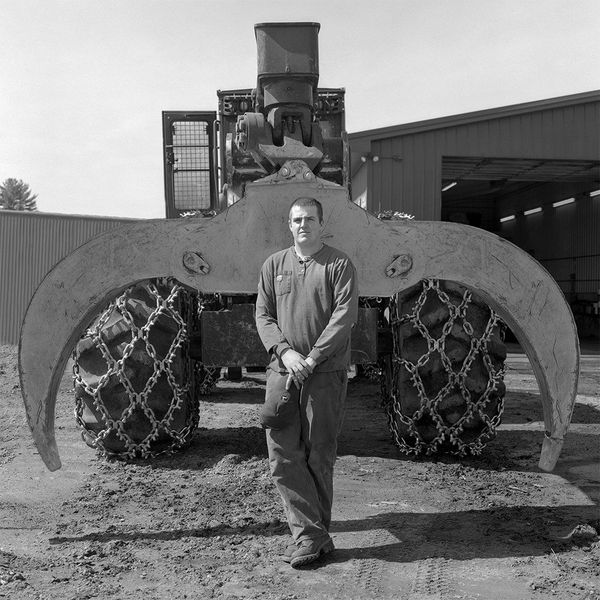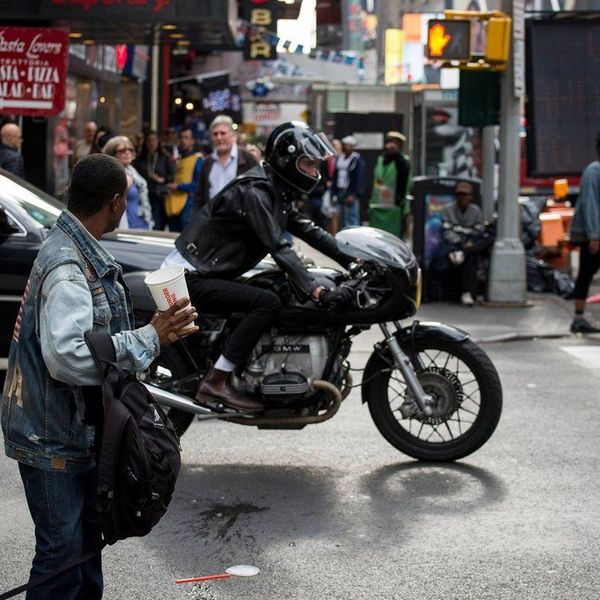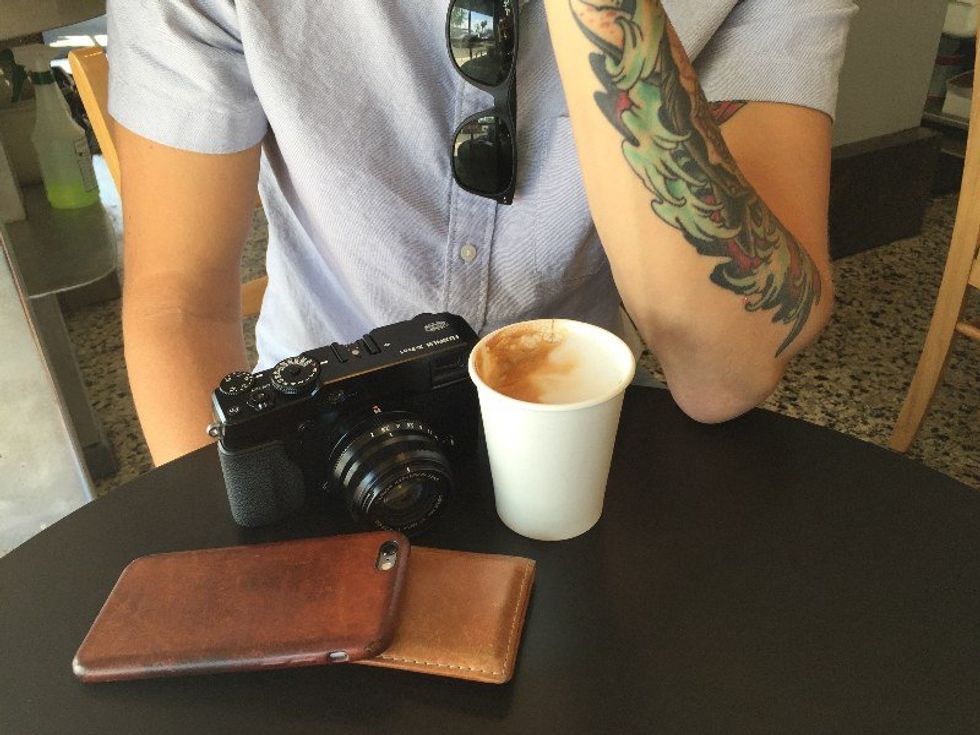If you’re a photography enthusiast, you’re probably already aware that there’s a certain amount of controversy surrounding mirrorless cameras. If you’re not a photography enthusiast, then let me inform you that there is indeed a certain degree of controversy surrounding mirrorless cameras.
Let’s get one thing straight. This is not an endorsement for any type of camera technology or manufacturer. All of the major camera companies offer equipment that will please people. Some people will have you think differently, claiming Canon, Nikon, Leica or another brand is the absolute king of all things photographic, and if you were to even consider equipment offered by a different manufacturer you must be some kind of idiot. This is simply not the case. So what is the case?
To put it simply; as you shoot, you develop a methodology, much of this is built around the equipment you use. Different cameras offer different ways of getting to the same point. Even something as simple as button arrangement can make or break a camera for people. What works for you, or what you prefer, is just a matter of personal preference. So let’s squash the beef as far as who makes a better system. Spend time figuring out what you like, and what works for you, then use that. Simple. Also, don’t use words like squash, and beef in the same sentence unless you’re discussing a delicious recipe.
When we obsess over gear, or button sniff, as Youtuber The Angry Photographer calls it, it can get in the way of actually making photographs, and thinking about what really matters, like seeing light, controlling it, and image composition. How about actually being in places where there are things going on to photograph? That’s why, for me, if something works for my style of shooting, I’m not going to obsess over every other offering on the market.
Here’s the takeaway of this whole article: The most important aspect of your equipment is not how well it works, but whether it encourages you to shoot with it. Let me explain. Obviously, we don’t want gear that doesn’t function, that would be silly. What I’m saying is that we want gear that encourages us to pick it up, and to take it with us when we leave the house. About a year ago I switched from a traditional, professional Nikon DSLR to a Fuji mirrorless body. What follows is the story of how I reacted to a new system that is very different from what I was used to. If I was writing a book, this chapter would be called “Fear.”
I was so fearful that my choice to give up the Nikon would somehow hurt my images. My nikon had a glorious full frame sensor, and I would be switching to a crop frame, which for technical reasons is regarded as inferior by some. I kept seeing stunning results from the Fuji cameras and their smaller sensors online through Flickr, 500px, and other photo sharing websites. I was enticed by the fact that the Fuji was more like a film camera in the way you adjust settings, and I was fascinated by its relatively small size. I knew I had to try it. The next chapter of my imaginary book is titled: The Hunt.
I called every camera shop in town. That’s really only a handful of places, but I kept getting the same answers, “We don’t have that in stock but we can order it for you and it should be here in a couple of weeks.” Or, “We don’t stock those” in a snooty tone. I was beginning to feel like I was chasing the red-headed stepchild of the camera world.
I am a full-time student, which means I am really not operating on a budget that allows me the luxuries of professional photography equipment in the first place. My Nikon rig had been put together as a result of years of saving, compromise, and selling things that are dear to me in order to afford a camera setup that would allow me to make images in very demanding situations. Furthermore, I didn’t really want to shell out for something I had never even held in my own hands. A compromise was necessary, but how?
I found that the older, less capable, but still highly lauded Fuji Xpro-1 body was available for very little coin. It wasn’t the exact camera I wanted, but it was the camera I could afford. I decided to order a used one and see what was what. To be honest, I wasn’t expecting to like it.
The Xpro-1 is a rangefinder style camera, think 70s silver, or black rectangle with the eyepiece off to the side. I wanted the XT-1, which is SLR style, where, with the help of a mirror and pentaprism, you essentially look through the lens. I needed to try the manual style controls and smaller body size Fuji was offering for myself, and the more I looked into images taken with my compromise camera, the Xpro-1, the more committed I was to give it a shot. Next chapter heading; “Deals on Wheels,” because “Deals on Ebay” sounds crap.
I located an insane deal for a used body, and picked up a 35mm f/2 fuji lens on sale too. I practically stole this stuff, that’s how cheap it was. I knew the camera wasn’t going to blow me away with it’s comparatively slow autofocus, but I thought, screw it, who cares? Eddie Adams and Larry Burrows didn’t need fast AF covering Vietnam. What about high ISO performance? Jim Marshall didn’t use low ISO film photographing Johnny Cash, or Muddy Waters in those dark, smoky clubs packed full of people. These guys transcended their equipment and made incredible images with, compared to what we have today, very humble technology.
I would just have to do the same with the Fuji. Comparing myself with Burrows, or Marshall is a tall order, on which I would surely fall short, but I can try, right? The 35mm lens mounted to the crop sensor Fuji is the functional equivalent of a 50mm lens on a film camera. Probably the same focal length the legends mentioned above used to create 90% of their most famous images. There are differences in how a 50mm lens on a 35mm sensor or film camera render an image, compared to a crop sensor, but that is technical, and for a different article. The 50mm focal length is often referred to as the nifty fifty. Regarded by many as the perfect do-everything lens. Next chapter: Day One.
The minute I opened the packaging and slid the body out into my hands I was puzzled. The Xpro-1 felt so good to hold, it was like I had been wearing the wrong size shoes all my life, and now I had slipped on a pair that actually fit. How can they manufacture stuff like this for anywhere near this price? That’s the thought that went through my head. Solid Japanese manufacturing that is built with attention to detail, precision, and will likely last a lifetime. I still wasn’t convinced that the camera would impress me with its images.
It was a warm spring afternoon, and the sun was about an hour away from setting. This is referred to as the “golden hour” by many photographers. I took some shots of leaves and grass blowing in the wind, textures on the street, orangy-yellow sunlight pouring across the sidewalk. Typical test shots, devoid of artistic value or purpose. When I got back to my computer and looked at the files, frankly I was taken aback. Somehow, these images I took purely to see how the sensor would render color, contrast, sharpness etcetera, had soul.
I was obsessed. I couldn’t put the Xpro-1 down. What started as an experiment, with a camera I viewed as being goofy-looking, and inferior to my Nikon in almost every way, became a love affair. I took that thing absolutely everywhere with me. It was easy to stuff into a backpack, or carry on my shoulder, and it wasn’t swinging around at my hip, searching diligently for door knobs, or table corners to destroy itself on like my like my big DSLR. Next Chapter: True Love.
Ok, so I was in love, but my new relationship wasn’t perfect. The autofocus that I had promised myself wouldn’t bother me did frustrate me at times. I was aware that I was missing shots, real candid moments of joy, smiles on children’s faces, things like that. Sometimes the camera would hunt for focus in low light too, and anything involving fast movement was a big challenge. It was annoying, but this was not a deal breaker given the quality of the images I was getting. I was aware of these drawbacks before I jumped into bed with the Fuji, and I knew that by getting the newer, much improved body, it would solve ninety percent of my woes. Next Chapter: Letting Go.
So, by this time the Nikon was gathering dust. I picked it up occasionally just to feel it in my hands, and I was always surprised at how big, and clunky it felt. Something to understand about mirrorless cameras, is that they are sold on how compact they are. Typical sales pitch for a mirrorless system, ready? Go! “Mirrorless cameras are the future, and they are much smaller than their DSLR counterparts. Size and weight, size and weight, size and weight…” Slap a 70-200mm on that bitch and tell me it’s smaller than a DSLR. I dare you.
The answer to the question of whether mirrorless cameras are smaller than DSLRs is: “It depends.” When I have my 35mm, or 23mm lens on, yes, my system is compact and easy to throw around and carry in a backpack or even a messenger bag, which I don’t have, but you might, along with a beard and a fixed gear bicycle. I’m kidding!! When I have a 50-140mm, or a 56mm, or a 10-24mm mounted, then the size and weight, when compared to a popular DSLR body and lens combo becomes so negligible that it’s not worth talking about. So don’t buy a mirrorless camera because it’s smaller and lighter, because they aren’t always.
The other major statement that gets made about mirrorless cameras is, “They are the future.” What does that even mean? There is no doubt that there are some incredible things in the pipeline for mirrorless cameras, but there are also major developments underway for DSLR technology. The truth is that by removing the mirror on your camera, you have to do a whole lot of electronical tomfoolery to get the image in the viewfinder. This is a major battery drain, and a technological pain in the ass. Mirrors are super robust, and cost nothing to activate energy-wise. So, mirrorless systems run out of juice far before DSLRs typically do. To give you a real life example, I would get anywhere from nine-hundred to twelve-hundred shots out of my Nikon before a battery change was necessary. With my Fuji, I get about three fifty.
There is a caveat here. I recently shot over six-hundred frames on one battery with my Xpro-2. But these were in very close succession, and I was also shooting continuous at about eight frames per second some of the time. Averaged out, you would expect a much lower number of shots on one battery, and the average is the important number, not the exception. The solution is simple and relatively cheap. Buy more batteries. They’re light, small, and easy to pack around. It’s really no skin off my nose to carry five batteries with me if I want, which sets me up for more frames than I would want, or like to take on any given day.
Let’s take a step back to where I was talking about methodology, and how the design of a camera effects how you shoot with it. I really felt good about how this camera handled. It inspired me. I liked how the dials moved, and how the buttons felt. It was a departure from my ultra modern, ultra efficient Nikon, but I never felt myself wanting for anything control-wise. Another interesting aspect of the camera that relates to methodology of shooting is “post processing”.
You make an image in-camera, then have the option to leave it how it is, or take that image into a software suite like Lightroom, Photoshop, or Capture One, and tinker until your creative dream is realized. Or something like that. There’s something about these Fuji cameras that has caused quite a stir in the photographic community, besides the fact that they don’t have a mirror. Jpegs!
Jpeg is an image file type. Typically, most professional photographers, and the large majority of hobbyist shooters, use a file type called RAW. These files are large in size, and large in data. They are great if you want or need to do a lot of post production on your images. Jpeg is a dirty word among some photogs, who believe that they are lower in quality, and inferior because of the lack of image data they contain. I’ll tell you this, I can’t remember the last time I shot Jpeg before I had the Fuji, over five years easily. The fuji changed that.
Prior to making high-tech scientific optics, and TV lenses, Fuji manufactured film! They made some truly legendary film stock, and will be known by any photographer who has, or is actively shooting film. Acros, Velvia, Provia. All these film types have very unique looks and feels. All of the Fuji cameras have a film simulation mode that allows the shooter to fairly accurately reproduce the look of these films in their Jpeg images, and they are amazing! The Jpeg film sims really opened my world up, encouraging me to play more with my camera and my composition and work less in post. For me, this is a good thing. And I don’t care if you don’t like Jpeg. There’s a time and a place.
I have since moved on from my first love, the Xpro-1. I bought a Fuji XT-1, then an Xpro-2, which is the camera body I use to this day. I sold my Nikon and all my lenses and equipment that was only compatible with Nikon. I still have a soft spot in my heart for DSLRs but I really don’t need one for the work I do.
I feel I need to reiterate that this is not a sales pitch. I am a huge advocate of using what works and discarding the rest. If a company released a camera tomorrow that had the function and feel of my Fuji but was ultimately a more useful system for me, or was priced better, I am not averse to jumping ship for a different company. Although I have romanticized it in this article, I very much feel that a camera is a tool, a means to make images, and that's it.
What is really important is that I have fallen back in love with photography. The Fuji camera just happened to be the right tool to draw me back in.




















